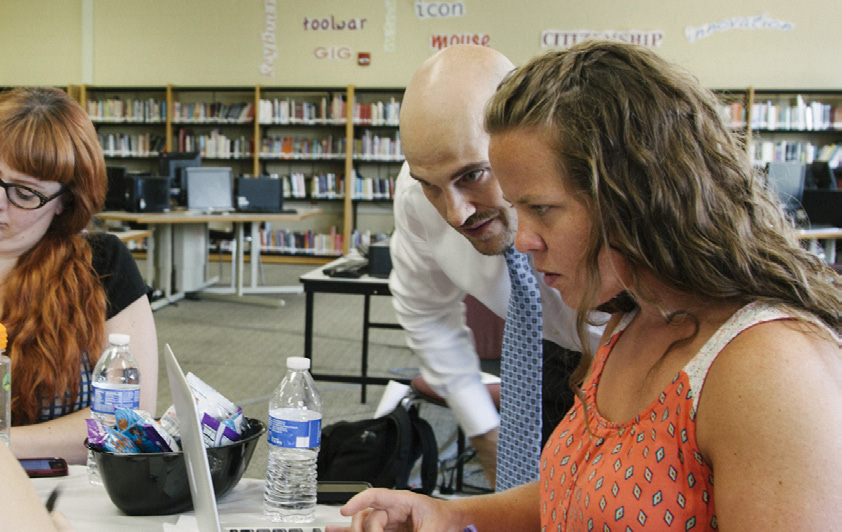5Essentials In Action: National Teachers Academy
“There’s not really anything that you do as a school leader that can’t fit in to [ the 5Essentials ] framework... it’s now a meaningful frame to the staff—it’s how they live.”
When Isaac Castelaz looked at the 5Essentials report for his school after completing his first year as principal there, he saw red. Lots of it. Then he cried.
The 2012-2013 school year, his first as principal at National Teachers Academy on Chicago’s Near South Side, had been a rocky one. He already knew that. The school’s 5Essentials results—until then strong under a popular previous principal—underscored just how rocky. Of 35 measures of school culture and climate, 30 were in the “weak” or “very weak” categories. Only one measure, teacher influence, was better than “neutral.”
Castelaz had no experience either as a principal or even in elementary schools. He and his assistant principal didn’t always see eye-to-eye, and teacher turnover surged upon his arrival.
“It was horrifying for me,” said Castelaz. “I knew that the year had been tough and I had a lot of struggles as a first year principal. But I would not have imagined that it was that bad.”
Castelaz wiped away the tears and got to work. He met with his staff and strategized together about how to embed 5Essentials results and data more generally into their strategic problem-solving meetings.
“We didn’t want to simply rely on our perceptions and how we felt in the building, which are important markers, but wanted something more quantitative based on the collective perception of staff,” said Castelaz, who added that the survey provided a framework from which to better understand the school’s weaknesses.
In short order, he and his staff decided it made most sense to focus on two areas they believed were both critical and movable: Collaborative Teachers and Effective Leaders. He created teacher focus groups around each area, then got out of the room so the groups could speak and brainstorm freely.
Teachers decided they wanted more opportunities to work with colleagues outside of their usual grade cycles, both professionally and socially, but didn’t want to be forced to do so. So Castelaz mixed up chairs at professional development sessions. He organized a Whirly Ball tournament one night so teachers could hang out, have a drink and crash electric bumper cars into each other. He created “Cookies with Castelaz,” a monthly opportunity for any staff person in the school to stop by and chat about anything they wanted.
In the 2014-15 school year, teachers now will be grouped in planning cohorts across three grades instead of two, to allow broader collaboration within the school as well as better course alignment.
One conclusion from the Effective Leaders group: Castelaz had to be mindful about the time and attention he was perceived to give to certain teachers, but not others. “Building relationships is not my strong suit, not that I can’t but I’m not nearly as intentional about it as I need to be,” he said. “One thing I did was I began to monitor who I was checking in with.”
Amy Rome, Castelaz’s predecessor as NTA’s principal and now his mentor as Director of School Leadership for NTA and seven other Academy for Urban School Leadership (AUSL) campuses, says Castelaz uses 5Essentials to both frame his improvement efforts and then message results to staff. “Because he’s benchmarked the work against it, I think it’s now a meaningful frame to the staff—it’s how they live,” Rome said.
National Teachers Academy’s focus and hard work, led by Castelaz, appears to be paying off. After the 2013-14 year, the school posted improvements in 26 of 35 measures. And not a drop of red in sight.
Autumn Laidler, a math and science teacher beginning her fourth year at NTA, says she’s definitely felt the changes reflected in the data.

“I think the thing that I saw last year from him, after digging into his Effective Leaders Essential, was the accountability and involvement of himself in realizing that being a leader wasn’t just being a leader on paper, it was about being a personal leader,” she said. “Then, too, making sure that his message was clear about what was expected of us and in turn what we should expect from our kids and that was a huge shift from last year. I think it really changed the culture of our school.”
Castelaz cautions his staff that the survey is not an end in itself. “We’re not doing all this work just to score ‘organized,’ but because we know that with more teacher collaboration, we’ll end up with better outcomes for our students.”



